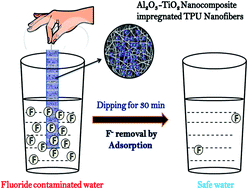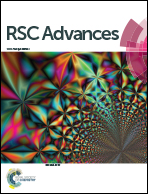Hybrid Al2O3/bio-TiO2 nanocomposite impregnated thermoplastic polyurethane (TPU) nanofibrous membrane for fluoride removal from aqueous solutions†
Abstract
In the present study, crystalline TiO2 nanoparticles were synthesized at room temperature using Bacillus licheniformis bacteria and were further modified using an alumina precursor to achieve a hybrid biologically and chemically synthesized Al2O3/TiO2 nanocomposite. This hybrid nanocomposite was impregnated onto electrospun thermoplastic polyurethane (TPU) nanofibers. The adhesion of the nanoparticles on the nanofibers was achieved through a silane functionalization of the materials. HRTEM images confirmed the proper impregnation of nanocomposite onto the nanofiber. The particle size and diameter of the nanocomposite and the nanofiber were determined to be 50 ± 6 nm and 239 ± 33 nm, respectively. Moreover, other membrane parameters, such as thickness, swelling ratio and porosity, were estimated. The nanocomposite impregnated nanofibrous membrane was tested for the removal of fluoride from aqueous solutions. The adsorption capacity (Q0) of the nanocomposite impregnated TPU nanofiber was found to be 1.9 mg g−1. This facile approach of designing a nanocomposite impregnated nanofiber membrane can be used in water purification applications.


 Please wait while we load your content...
Please wait while we load your content...